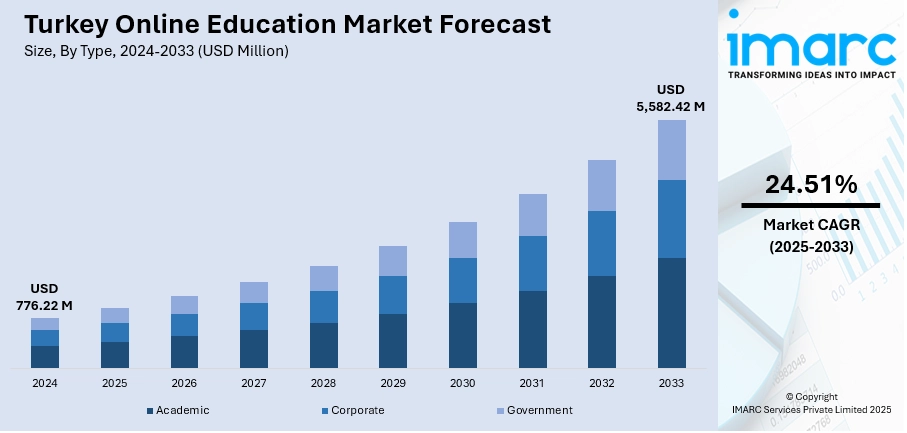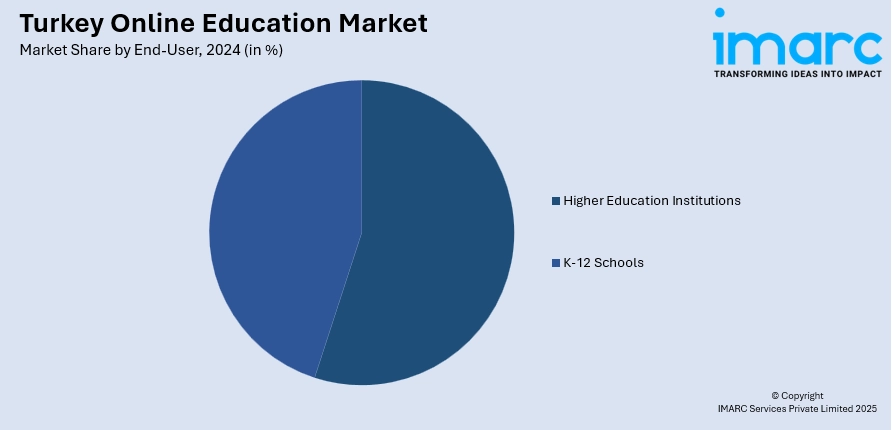
Turkey Online Education Market Size, Share, Trends and Forecast by Type, Provider, Technology, End-User, and Region, 2025-2033
Turkey Online Education Market Overview:
The Turkey online education market size reached USD 776.22 Million in 2024. Looking forward, the market is expected to reach USD 5,582.42 Million by 2033, exhibiting a growth rate (CAGR) of 24.51% during 2025-2033. The market is experiencing rapid growth, driven by increased internet access and demand for flexible learning options. Key factors including the rise of e-learning platforms, government initiatives, and a focus on upskilling are also escalating the product demand. The expanding market across K-12, higher education, and professional development sectors is driven by a young, tech-savvy population in Turkey, further contributing to the Turkey online education market share.
|
Report Attribute
|
Key Statistics
|
|---|---|
|
Base Year
|
2024
|
|
Forecast Years
|
2025-2033
|
|
Historical Years
|
2019-2024
|
| Market Size in 2024 | USD 776.22 Million |
| Market Forecast in 2033 | USD 5,582.42 Million |
| Market Growth Rate 2025-2033 | 24.51% |
Turkey Online Education Market Trends:
Blended Learning Models
Blended learning, where online learning is mixed with conventional classroom instruction, is swiftly picking up pace in Turkey. This blended model gives students flexibility by incorporating the amenity of online courses coupled with the necessary interaction and structure of conventional face-to-face instruction. Numerous universities and schools are embracing this model to increase student interaction and support different learning styles. By combining online resources such as interactive platforms, virtual classrooms, and video lectures with face-to-face sessions, higher learning institutions are able to deliver more personalized and dynamic learning experiences. For instance, in April 2023, the Council of Higher Education announced that Turkish universities will implement a hybrid education model. This model allows students the choice to attend classes either in-person or online. The flexibility of blended learning has been especially appealing to adult learners and working professionals seeking to balance education with other commitments. As this model becomes more mainstream it contributes significantly to the expansion of the online education sector. The rising popularity of blended learning is a driving force behind Turkey online education market growth.

To get more information on this market, Request Sample
Rise of E-learning Platforms
Growing use of e-learning platforms in Turkey is revolutionizing the education industry extending from K-12 to higher education and professional courses. With an expansion of internet coverage and a population with high levels of technological awareness students are now opting for online platforms as means of flexible and convenient learning. Top universities and institutes have brought on board digital learning tools and resources, providing degree courses, certifications, and courses on their online portals. Meanwhile, K-12 learning is being aided by interactive web-based classes which are allowing students to leverage high-quality content beyond the walls of a classroom. Furthermore, professional training and reskilling are being propelled by an explosion in online training courses aimed at corporate executives as well as those looking for career enhancement. The platforms' growth is underpinned by the growing demand for customized and on-demand learning experiences with the growing need for affordable alternatives for conventional education practices. For instance, in August 2024, the Turkish Tourism Board introduced "All in Türkiye," an online learning platform for travel agents and tour operators. Currently offering 30 courses on Turkish history and tourism, the program aims to enhance knowledge and certifications, helping professionals attract clients and elevate their selling skills.
Turkey Online Education Market Segmentation:
IMARC Group provides an analysis of the key trends in each segment of the market, along with forecasts at the country and regional levels for 2025-2033. Our report has categorized the market based on type, provider, technology, and end-user.
Type Insights:
- Academic
- Higher Education
- Vocational Training
- K–12 Education
- Corporate
- Large Enterprises
- SMBs
- Government
The report has provided a detailed breakup and analysis of the market based on the type. This includes academic (higher education, vocational training, and K–12 education), corporate (large enterprises and SMBs), and government.
Provider Insights:
- Content
- Services
A detailed breakup and analysis of the market based on the provider have also been provided in the report. This includes content and services.
Technology Insights:
- Mobile E-Learning
- Rapid E-Learning
- Virtual Classroom
- Others
A detailed breakup and analysis of the market based on the technology have also been provided in the report. This includes mobile e-learning, rapid e-learning, virtual classroom, and others.
End-User Insights:

- Higher Education Institutions
- K–12 Schools
A detailed breakup and analysis of the market based on the end-user have also been provided in the report. This includes higher education institutions and K–12 schools.
Regional Insights:
- Marmara
- Central Anatolia
- Mediterranean
- Aegean
- Southeastern Anatolia
- Blacksea
- Eastern Anatolia
The report has also provided a comprehensive analysis of all the major regional markets, which include Marmara, Central Anatolia, Mediterranean, Aegean, Southeastern Anatolia, Blacksea, and Eastern Anatolia.
Competitive Landscape:
The market research report has also provided a comprehensive analysis of the competitive landscape. Competitive analysis such as market structure, key player positioning, top winning strategies, competitive dashboard, and company evaluation quadrant has been covered in the report. Also, detailed profiles of all major companies have been provided.
Turkey Online Education Market News:
- In May 2025, NCC Education formed an academic partnership with Stonebridge University to enhance access to UK-accredited online degree pathways for students in Turkey. This collaboration allows Turkish students to pursue qualifications in various fields, promoting flexible learning and removing traditional barriers to education.
- In December 2023, Ders.TV launched an innovative online learning platform in Turkey, connecting students with qualified educators across various subjects. The platform offers extensive courses, certified instructors, and a user-friendly interface, including free options to promote accessible education and foster a community of knowledge-sharing among learners.
Turkey Online Education Market Report Coverage:
| Report Features | Details |
|---|---|
| Base Year of the Analysis | 2024 |
| Historical Period | 2019-2024 |
| Forecast Period | 2025-2033 |
| Units | Million USD |
| Scope of the Report |
Exploration of Historical Trends and Market Outlook, Industry Catalysts and Challenges, Segment-Wise Historical and Future Market Assessment:
|
| Types Covered |
|
| Providers Covered | Content, Services |
| Technologies Covered | Mobile E-Learning, Rapid E-Learning, Virtual Classroom, Others |
| End-Users Covered | Higher Education Institutions, K-12 Schools |
| Regions Covered | Marmara, Central Anatolia, Mediterranean, Aegean, Southeastern Anatolia, Blacksea, Eastern Anatolia |
| Customization Scope | 10% Free Customization |
| Post-Sale Analyst Support | 10-12 Weeks |
| Delivery Format | PDF and Excel through Email (We can also provide the editable version of the report in PPT/Word format on special request) |
Key Questions Answered in This Report:
- How has the Turkey online education market performed so far and how will it perform in the coming years?
- What is the breakup of the Turkey online education market on the basis of type?
- What is the breakup of the Turkey online education market on the basis of provider?
- What is the breakup of the Turkey online education market on the basis of technology?
- What is the breakup of the Turkey online education market on the basis of end-user?
- What is the breakup of the Turkey online education market on the basis of region?
- What are the various stages in the value chain of the Turkey online education market?
- What are the key driving factors and challenges in the Turkey online education market?
- What is the structure of the Turkey online education market and who are the key players?
- What is the degree of competition in the Turkey online education market?
Key Benefits for Stakeholders:
- IMARC’s industry report offers a comprehensive quantitative analysis of various market segments, historical and current market trends, market forecasts, and dynamics of the Turkey online education market from 2019-2033.
- The research report provides the latest information on the market drivers, challenges, and opportunities in the Turkey online education market.
- Porter's five forces analysis assist stakeholders in assessing the impact of new entrants, competitive rivalry, supplier power, buyer power, and the threat of substitution. It helps stakeholders to analyze the level of competition within the Turkey online education industry and its attractiveness.
- Competitive landscape allows stakeholders to understand their competitive environment and provides an insight into the current positions of key players in the market.
Need more help?
- Speak to our experienced analysts for insights on the current market scenarios.
- Include additional segments and countries to customize the report as per your requirement.
- Gain an unparalleled competitive advantage in your domain by understanding how to utilize the report and positively impacting your operations and revenue.
- For further assistance, please connect with our analysts.
 Request Customization
Request Customization
 Speak to an Analyst
Speak to an Analyst
 Request Brochure
Request Brochure
 Inquire Before Buying
Inquire Before Buying




.webp)




.webp)












